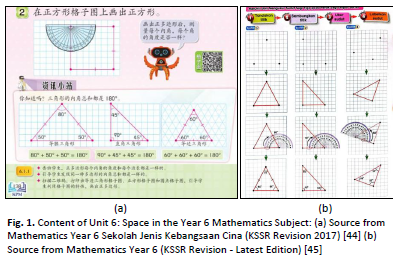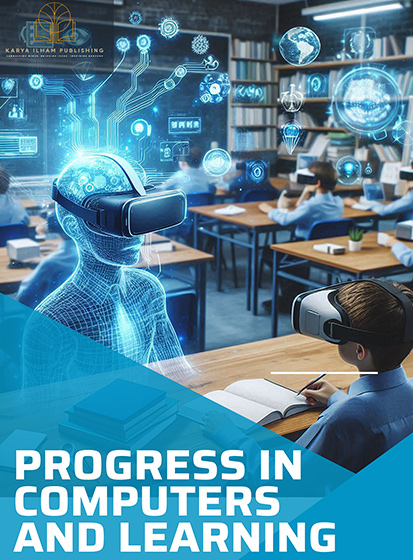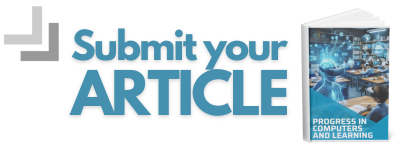Design and Development of ExploreGeo Kit: Integrating Social Constructivism Theory in Game-Based Learning to Enhance Geography Concept Mastery
DOI:
https://doi.org/10.37934/picl.4.1.117Keywords:
Social constructivism theory, game-based learning, interactive multimedia, addie model, geographyAbstract
As Malaysia’s education landscape continues to evolve rapidly, the integration of technology-driven learning approaches has become more essential than ever. Thus, this paper presents the development of a learning kit called the ExploreGeo Kit. This kit serves as a learning material that employs a game-based learning approach to enhance secondary school students’ understanding of fundamental geography concepts, specifically for the topics of Wind Direction and Angular Bearings. Despite proven benefits and positive responses towards multimedia-assisted teaching and learning, interactive multimedia applications or learning materials for geography subjects remain limited. Therefore, a systematic design and development of teaching aids was undertaken by applying the ADDIE instructional design model, which encompasses the phases of Analysis, Design, Development, Implementation, and Evaluation. In addition, Vygotsky’s Social Constructivism Theory, which includes scaffolding, peer collaboration, and experiential learning, was integrated into the design and development process of the ExploreGeo Kit. Therefore, this paper provides educators with insights into developing interactive multimedia that foster enjoyment and engagement in learning.
Downloads
References
[1] A. A. Halim, N. Dayana, A. Halim, and M. Raharjo, “Semarak International Journal of STEM Education Engaging Young Minds: A Systematic Literature Review on the Role of Blended Learning Models in Primary Education,” Semarak International Journal of STEM Education, vol. 5, pp. 14–36, 2025. https://doi.org/10.37934/sijste.5.1.1436 DOI: https://doi.org/10.37934/sijste.5.1.1436b
[2] N. H. Othman and S. Mohamed, “Pendekatan Kelas Berbalik bagi Subjek Matematik Awal dalam Proses Pengajaran dan Pembelajaran,” Malaysian Journal of Social Sciences and Humanities (MJSSH), vol. 8, no. 4, p. e002202, Apr. 2023. https://doi.org/10.47405/mjssh.v8i4.2202 DOI: https://doi.org/10.47405/mjssh.v8i4.2202
[3] Mohd Erfy Ismail, C. M. F. E. Che Mut, S. Hashim, A. Ismail, R. Abd. Hamid, and I. M. Ismail, “Development of Augmented Reality Learning Kit for the TVET Course at Vocational College,” Semarak International Journal of STEM Education, vol. 5, no. 1, pp. 1–13, Mar. 2025. https://doi.org/10.37934/sijste.5.1.113 DOI: https://doi.org/10.37934/sijste.5.1.113
[4] M. H. M. Chen, S. T. Tsai, and C. C. Chang, “Effects of game-based instruction on the results of primary school children taking a natural science course,” Educ Sci (Basel), vol. 9, no. 2, p. 79, Jun. 2019. https://doi.org/10.3390/educsci9020079 DOI: https://doi.org/10.3390/educsci9020079
[5] C. Lange and J. Costley, “Improving online video lectures: learning challenges created by media,” International Journal of Educational Technology in Higher Education, vol. 17, no. 1, Dec. 2020. https://doi.org/10.1186/s41239-020-00190-6 DOI: https://doi.org/10.1186/s41239-020-00190-6
[6] Malaysia, Ministry of Education, “Educational Service Circular of the Ministry of Education Malaysia Number 9 Year 2016: Implementation of the Standard Curriculum for Secondary Schools in Stages Starting from 2017.” Putrajaya: Federal Government Administrative Centre, 2016.
[7] K. J. E. Hewett, G. Zeng, and B. C. Pletcher, “The Acquisition of 21st-Century Skills Through Video Games: Minecraft Design Process Models and Their Web of Class Roles,” Simul Gaming, vol. 51, no. 3, pp. 336–364, Jun. 2020. https://doi.org/10.1177/1046878120904976 DOI: https://doi.org/10.1177/1046878120904976
[8] S. S. Farooq, H. Rahman, S. A. N. Raza, M. Raees, and S. K. Jung, “Design for Game-based Learning Application: An Effective Integration of Technology to Support Learning,” IEEE Access, pp. 1–1, Nov. 2022. https://doi.org/10.1109/ACCESS.2022.3221473 DOI: https://doi.org/10.1109/ACCESS.2022.3221473
[9] F. W. Amran and M. Makhsin, “Semarak International Journal of Innovation in Learning and Education Inovasi Cerdik Jawi Menggunakan Pembelajaran Kinestatik dan Koperatif Meningkatkan Kemahiran Menulis Jawi dalam Kalangan Murid Sekolah Rendah Inovasi Cerdik Jawi using Kinesthetic and Cooperative Learning in Improving Jawi Writing Skill among Primary Pupils,” Semarak International Journal of Innovation in Learning and Education, vol. 2, pp. 25–35, 2024. DOI: https://doi.org/10.37934/sijile.2.1.2535
[10] F. Suárez, J. C. M. Feijóo, I. Chiyón, and M. G. Alberti, “Flipped Learning in Engineering Modules Is More Than Watching Videos: The Development of Personal and Professional Skills,” Sustainability, vol. 13, no. 21, p. 12290, 2021. https://doi.org/10.3390/su132112290 DOI: https://doi.org/10.3390/su132112290
[11] Z. Y. Liu, Z. A. Shaikh, and F. Gazizova, “Using the concept of game-based learning in education,” International Journal of Emerging Technologies in Learning, vol. 15, no. 14, pp. 53–64, 2020. https://doi.org/10.3991/ijet.v15i14.14675 DOI: https://doi.org/10.3991/ijet.v15i14.14675
[12] J. D. Lux, A. Budke, and E. Guardiola, “Games versus reality? How game designers deal with current topics of geography education,” Multimodal Technologies and Interaction, vol. 5, no. 11, pp. 1–26, Nov. 2021. https://doi.org/10.3390/mti5110070 DOI: https://doi.org/10.3390/mti5110070
[13] I. G. Budasi, N. M. Ratminingsih, K. Agustini, and M. Y. Risadi, “Power point game, motivation, achievement: The impact and students’ perception,” International Journal of Instruction, vol. 13, no. 4, pp. 509–522, 2020. https://doi.org/10.29333/iji.2020.13432a DOI: https://doi.org/10.29333/iji.2020.13432a
[14] A. Pramono, P. Pujiyanto, B. D. Puspasari, and N. S. Dhanti, “Character Thematic Education Game ‘AK@R’ of Society Themes for Children with Malang-Indonesian Visualize,” International Journal of Instruction, vol. 14, no. 2, pp. 179–196, Apr. 2021. https://doi.org/10.29333/iji.2021.14211a DOI: https://doi.org/10.29333/iji.2021.14211a
[15] M. Z. @ S. Ahmad, “Pendidikan Geografi di Sekolah-Sekolah Malaysia: Perkembangan dan Isu Geography Education in Malaysian Schools: Development and Issues,” no. 4, pp. 1–10, 2016.
[16] S. S. Estawul, L. K. Sababa, and J. Filgona, “Effect of Fieldtrip Strategy on Senior Secondary School Students’ Academic Achievement in Geography in Numan Educational Zone, Adamawa State, Nigeria Effect of Fieldtrip Strategy on Senior Secondary School Students’ Academic Achievement in Geography in Numan Educational Zone, Adamawa State, Nigeria,” European Journal of Education Studies, vol. 2, no. 12, pp. 138–154, 2016. http://dx.doi.org/10.46827/ejes.v0i0.386
[17] J. Filgona and L. K. Sababa, “Effect of Gender on Senior Secondary School Students’ Academic Achievement in Geography in Ganye Educational Zone, Nigeria,” European Journal of Education Studies, vol. 3, no. 4, pp. 394–410, 2017. http://dx.doi.org/10.46827/ejes.v0i0.593
[18] S. K. Nazimuddin, “Effect of Advance Organizer Model (AOM) on Pupil’s Academic Achievement in Geography - A Study,” International Journal of Scientific Engineering and Research (IJSER), vol. 3, no. 7, pp. 18–23, 2015, [Online]. Available: www.ijser.in DOI: https://doi.org/10.70729/IJSER15309
[19] G. A. Okafor, “Effect of Concept Mapping and Outline Note-Taking Patterns in Students Academic Achievement in Geography in Secondary Schools in Enugu South Lga of Enugu State,” Journal of Education and Practice, vol. 7, no. 5, pp. 53–60, 2016, [Online]. Available: www.iiste.org
[20] U. S. Putra and M. S. Masruri, “The Effectiveness Comparison Between Inquiry and Problem Based Learning Towards Geography Learning Outcomes,” Geosfera Indonesia, vol. 4, no. 2, p. 146, Aug. 2019. https://doi.org/10.19184/geosi.v4i2.10849 DOI: https://doi.org/10.19184/geosi.v4i2.10849
[21] H. Tüzün, M. Yilmaz-Soylu, T. Karakuş, Y. Inal, and G. Kizilkaya, “The effects of computer games on primary school students’ achievement and motivation in geography learning,” Comput Educ, vol. 52, no. 1, pp. 68–77, Jan. 2009. https://doi.org/10.1016/j.compedu.2008.06.008 DOI: https://doi.org/10.1016/j.compedu.2008.06.008
[22] N. Suarsini, I. Wesnawa, and I. W. Kertih, “Pengembangan Media Pembelajaran Geografi Berbasis Media Sosial Instagram untuk Peningkatan Motivasi dan Hasil Belajar Siswa,” Jurnal Pendidikan IPS Indonesia, vol. 4, no. 2, 2020. https://doi.org/10.23887/pips.v4i2.3386
[23] W. Y. Rejeki and M. Mukminan, “Development of Multimedia Learning Geography Based on Adobe Flash to Increase Students’ Curiosity,” Geosfera Indonesia, vol. 5, no. 3, p. 318, Dec. 2020. https://doi.org/10.19184/geosi.v5i3.14765 DOI: https://doi.org/10.19184/geosi.v5i3.14765
[24] D. Azis, M. Desfandi, A. W. Abdi, and A. N. Gadeng, “The Identification Misconception in Geography Learning During Covid-19 Pandemic Using Three-Tier Diagnostic Test,” International Journal of Instruction, vol. 16, no. 4, pp. 87–100, Oct. 2023. https://doi.org/10.29333/iji.2023.1646a DOI: https://doi.org/10.29333/iji.2023.1646a
[25] S. P. Prasetya, “Effect of Learning Media Variation to Increase Interest and Learning Outcomes of Geography,” in 2nd International Conference on Education Innovation (ICEI 2018), 2018, pp. 558–561. DOI: https://doi.org/10.2991/icei-18.2018.122
[26] T. Çifçi, “Effects of Infographics on Students Achievement and Attitude towards Geography Lessons,” Journal of Education and Learning, vol. 5, no. 1, p. 154, Jan. 2016. https://doi.org/10.5539/jel.v5n1p154 DOI: https://doi.org/10.5539/jel.v5n1p154
[27] M. I. M. Caesar, R. Jawawi, R. Matzin, M. Shahrill, J. H. Jaidin, and L. Mundia, “The Benefits of Adopting a Problem-Based Learning Approach on Students’ Learning Developments in Secondary Geography Lessons,” International Education Studies, vol. 9, no. 2, p. 51, Jan. 2016. https://doi.org/10.5539/ies.v9n2p51 DOI: https://doi.org/10.5539/ies.v9n2p51
[28] M. S. Al Zboon, S. A. D. Al Ghammaz, and M. S. Al Zboon, “The Impact of the Use of YouTube and Facebook on Students’ Academic Achievement in Geography Course at the University of Jordan for the Bachelor’s Degree,” Mod Appl Sci, vol. 12, no. 3, p. 164, Feb. 2018. https://doi.org/10.5539/mas.v12n3p164 DOI: https://doi.org/10.5539/mas.v12n3p164
[29] P. Doolittle, K. Wojdak, and A. Walters, “Defining Active Learning: A Restricted Systematic Review,” Teaching and Learning Inquiry, vol. 11, 2023. https://doi.org/10.20343/teachlearninqu.11.25 DOI: https://doi.org/10.20343/teachlearninqu.11.25
[30] R. H. Nehm, S. J. Finch, and G. C. Sbeglia, “Is Active Learning Enough? The Contributions of Misconception-Focused Instruction and Active-Learning Dosage on Student Learning of Evolution,” Bioscience, vol. 72, no. 11, pp. 1105–1117, Nov. 2022. https://doi.org/10.1093/biosci/biac073 DOI: https://doi.org/10.1093/biosci/biac073
[31] A. Patiño, M. S. Ramírez-Montoya, and M. Buenestado-Fernández, “Active learning and education 4.0 for complex thinking training: analysis of two case studies in open education,” Smart Learning Environments, vol. 10, no. 1, Dec. 2023. https://doi.org/10.1186/s40561-023-00229-x DOI: https://doi.org/10.1186/s40561-023-00229-x
[32] D. Lombardi et al., “The Curious Construct of Active Learning,” Psychological Science in the Public Interest, vol. 22, no. 1, pp. 8–43, Apr. 2021. https://doi.org/10.1177/1529100620973974 DOI: https://doi.org/10.1177/1529100620973974
[33] L. S. Vygotsky, “Mind in society: The development of higher psychological processes”. Cambridge, MA: Harvard University Press, 1978.
[34] J. Piaget, “The language and thought of the child (2nd ed.)”. Routledge & Kegan Paul, 1959.
[35] I. Verenikina, “Vygotsky in Twenty-First-Century Research,” in World Conference on Educational Media and Technology 2010, Association for the Advancement of Computing in Education (AACE), 2010, pp. 16–25. [Online]. Available: https://ro.uow.edu.au/edupapers.https://ro.uow.edu.au/edupapers/1022
[36] K. Durairaj and I. N. Umar, “A Proposed Conceptual Framework in Measuring Social Interaction and Knowledge Construction Level in Asynchronous Forum among University Students,” in Procedia - Social and Behavioral Sciences 176, Elsevier BV, Feb. 2015, pp. 451–457. https://doi.org/10.1016/j.sbspro.2015.01.496 DOI: https://doi.org/10.1016/j.sbspro.2015.01.496
[37] R. Al-Abdulkareem and G. C. Hentschke, “Textbooks and Constructivist Pedagogy in Saudi Arabian School Classrooms,” Journal of Curriculum and Teaching, vol. 3, no. 2, Jul. 2014. https://doi.org/10.5430/jct.v3n2p13 DOI: https://doi.org/10.5430/jct.v3n2p13
[38] D. Wray, & M. Lewis, “Extending literacy”. London: Routledge Falmer, 1997.
[39] F. D. Fatih, E. Suharini, and T. B. Sanjoto, “Self-Regulation and Problem-Solving Ability on Geography Basic Knowledge Materials Using the 7E-Learning Cycle Model,” in International Conference on Science and Education and Technology (ISET 2019), 2020, pp. 229–233. DOI: https://doi.org/10.2991/assehr.k.200620.045
[40] R. Adanali, “How Geogames Can Support Geographical Education?” Review of International Geographical Education (RIGEO), vol. 11, no. 1, pp. 215–235, 2021. https://doi.org/10.33403/rigeo.855550 DOI: https://doi.org/10.33403/rigeo.855550
[41] S. Y. Chen, J. C. Tsai, S. Y. Liu, and C. Y. Chang, “The effect of a scientific board game on improving creative problem-solving skills,” Think Skills Creat, vol. 41, Sep. 2021. https://doi.org/10.1016/j.tsc.2021.100921 DOI: https://doi.org/10.1016/j.tsc.2021.100921
[42] M. Xu, Y. Luo, Y. Zhang, R. Xia, H. Qian, and X. Zou, “Game-based learning in medical education,” Front Public Health, no. 11, p. 1113682, 2023. DOI: https://doi.org/10.3389/fpubh.2023.1113682
[43] P. Mikrouli, K. Tzafilkou, and N. Protogeros, “Applications and Learning Outcomes of Game Based Learning in Education,” International Educational Review, pp. 25–54, Mar. 2024. https://doi.org/10.58693/ier.212 DOI: https://doi.org/10.58693/ier.212
[44] Y. X. Voon, & A. S. Kor, “Matematik Tahun 6 Sekolah Jenis Kebangsaan Cina (KSSR Semakan 2017)”. Penerbit Bestari Sdn. Bhd, 2022.
[45] Y. Q. Yew, C. M. Yee, & N. I. Raihan, “Matematik Tahun 6: KSSR Semakan (Edisi Terbaharu)”. PNI Neuron (M) Sdn. Bhd, 2024.
[46] M. Prensky, “Fun, Play and Games: What Makes Games Engaging”. In Digital Game-Based Learning: Vol. 5(1) (pp. 5–31). McGraw-Hill, 2001.
[47] J. K. Knight, D. C. Weaver, M. E. Peffer, and Z. S. Hazlett, “Relationships between Prediction Accuracy, Metacognitive Reflection, and Performance in Introductory Genetics Students,” CBE—Life Sciences Education, vol. 21, no. 3, 2022. DOI: https://doi.org/10.1187/cbe.21-12-0341
[48] A. Reinhard, A. Felleson, P. C. Turner, and M. Green, “Assessing the impact of metacognitive postreflection exercises on problem-solving skillfulness,” Phys Rev Phys Educ Res, vol. 18, no. 1, Jun. 2022. https://doi.org/10.1103/PhysRevPhysEducRes.18.010109 DOI: https://doi.org/10.1103/PhysRevPhysEducRes.18.010109















